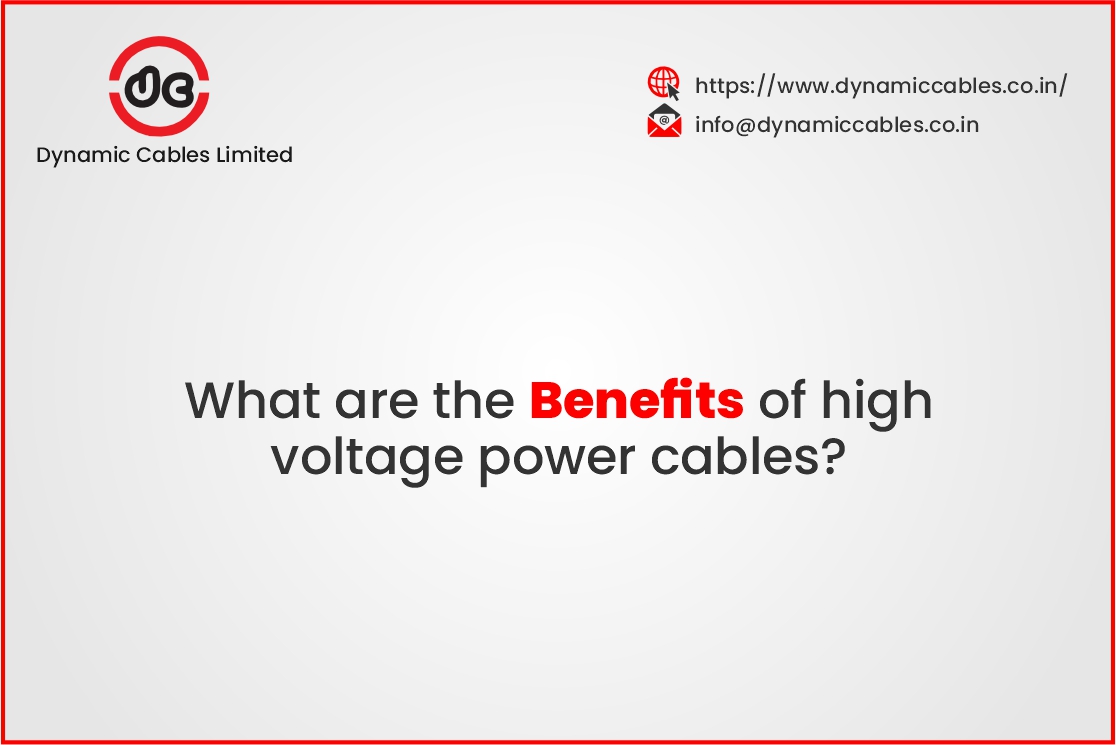- An ISO 9001:2015, 14001:2015 & 45001:2018 Company

What are the Benefits of high voltage power cables?
Power distribution is crucial in keeping industries, businesses, and households running smoothly in the modern era. Among the key components of power systems, high-voltage power cables stand out for their role in transmitting electricity over long distances with minimal losses. These cables are designed to handle high levels of electrical energy and are integral in transmitting electricity from power plants to cities, towns, and industries. XLPE power cables are the most commonly used types for high-voltage applications.
What Makes ACSR Conductors the Ideal Choice?
High-voltage power cables are designed to carry electrical current at voltages higher than standard voltage cables. They are used in transmission lines, substations, and other parts of the electrical grid to ensure efficient electricity transport across vast distances. The high-voltage power cables typically have insulation materials like PVC (Polyvinyl Chloride) or XLPE (Cross-Linked Polyethylene), which provide the necessary protection against electrical faults and environmental factors.
Key Benefits of High Voltage Power Cables
- Efficient Power Transmission Over Long Distances: One of the most significant benefits of high-voltage power cables is their ability to transmit power over long distances efficiently. High-voltage transmission minimizes energy loss, which would otherwise be higher in low-voltage transmission systems. When electricity is transmitted at a high voltage, it reduces the current flowing through the cable, reducing resistive losses. This is especially important in large-scale power grids, where electricity must travel hundreds or thousands of kilometres from the source to consumers.
By reducing power loss, high-voltage power cables help improve the overall efficiency of the electrical grid and ensure that a higher percentage of the generated power reaches end-users. - Increased Transmission Capacity: Another benefit of high-voltage power cables is that they can carry more electricity without increasing the size or number of the wires. High voltage allows the same cable to transmit more power, which is essential for meeting the growing electricity demand. This is particularly useful in densely populated areas or industries requiring large amounts of electricity.
Additionally, XLPE power cables, known for their excellent thermal properties, can withstand higher temperatures, making them ideal for high-voltage applications where the cable needs to handle significant power without overheating. - Durability and Longevity:High-voltage power cables, especially those made with materials like XLPE or PVC, are built to withstand harsh environmental conditions. These cables are designed to be durable and long-lasting, ensuring they can operate efficiently over many years without frequent replacements. PVC power cables are known for their resistance to moisture, chemicals, and UV rays, while XLPE power cables offer excellent resistance to temperature extremes, abrasion, and corrosion.
This durability and longevity mean lower maintenance costs for power plants, utilities, and other infrastructure operators, as they frequently don’t need to replace or repair the cables. - Flexibility in Installation: Another advantage of high-voltage power cables is their installation flexibility. PVC power cables are known for being lightweight and easy to handle, making installation quicker and more cost-effective. They can be installed in both overhead and underground power lines, offering flexibility in how power distribution systems are set up.
In addition, XLPE power cables have a more compact design, which makes them easier to transport and install, even in difficult-to-reach locations. This installation flexibility reduces labour and material costs, making high-voltage power cables a more economical choice for large-scale power transmission projects. - Environmental Resistance:High-voltage power cables, especially XLPE power cables, are designed to resist environmental factors like moisture, temperature changes, and chemical exposure. These cables are built to handle extreme conditions such as underground installations, coastal regions with high humidity, or areas prone to temperature fluctuations. The robust insulation ensures the cable’s performance is not compromised, even when exposed to challenging environmental factors.
This resistance to environmental stress makes high-voltage power cables ideal for both urban and rural electrification and industrial applications.
What are the Benefits of high voltage power cables?
As a trusted manufacturer of ACSR conductors, Dynamic Cables stands out as one of the leading cable manufacturers in India. We understand the critical role of ACSR conductors in maintaining a stable and efficient power supply. Our ACSR conductors are engineered to meet international standards, ensuring optimal performance and reliability. With years of experience and cutting-edge technology, we provide conductors that are durable and cost-effective. At Dynamic Cables, we pride ourselves on delivering products that meet the highest quality benchmarks. Our ACSR conductors undergo rigorous testing to withstand harsh environmental conditions and provide excellent electrical performance. Whether designing a new power line or upgrading existing infrastructure, Dynamic Cables is your trusted partner for all your ACSR conductor needs.
Conclusion
In conclusion, ACSR stands out as the most efficient and reliable option when choosing the right conductor for power transmission. With its combination of high electrical conductivity, mechanical strength, and durability, ACSR continues to be the conductor of choice for overhead transmission and distribution lines. By choosing Dynamic Cables for your ACSR conductor requirements, you can trust that you're investing in high-quality products that will deliver exceptional performance and reliability for years. As one of the leading cable manufacturers in India, Dynamic Cables is committed to support the growth of modern electrical infrastructure with superior ACSR solutions.
 English
English

 C701, Tower-C, Noida One
C701, Tower-C, Noida One
